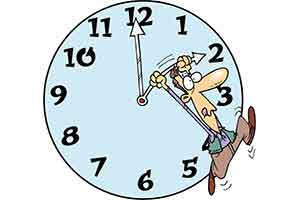Does Daylight Saving Time Increase Risk of Stroke?
 Turning the clock ahead or back one hour during daylight saving time transitions may be tied to an increased risk of ischemic stroke, but only temporarily, according to a preliminary study released that will be presented at the American Academy of Neurology’s 68th Annual Meeting.
Turning the clock ahead or back one hour during daylight saving time transitions may be tied to an increased risk of ischemic stroke, but only temporarily, according to a preliminary study released that will be presented at the American Academy of Neurology’s 68th Annual Meeting.
Ischemic stroke is the most common kind of stroke, accounting for 87 percent of all cases. It is caused by a clot blocking blood flow to the brain.
“Previous studies have shown that disruptions in a person’s circadian rhythm, also called an internal body clock, increase the risk of ischemic stroke, so we wanted to find out if daylight saving time was putting people at risk,” said study author Jori Ruuskanen, MD, PhD, of the University of Turku in Turku, Finland.
For the study, researchers looked at a decade of data for stroke in Finland to find the rate of stroke. They compared the rate of stroke in 3,033 people hospitalized during the week following a daylight saving time transition to the rate of stroke in a group of 11,801 people hospitalized either two weeks before or two weeks after that week.
Researchers found that the overall rate of ischemic stroke was 8 percent higher during the first two days after a daylight saving time transition. There was no difference after two days.
People with cancer were 25 percent more likely to have a stroke after daylight saving time than during another period. The risk was also higher for those over age 65, who were 20 percent more likely to have a stroke right after the transition.
Hospital deaths from stroke did not increase in the week after a daylight saving time transition.
“Further studies must now be done to better understand the relationship between these transitions and stroke risk and to find out if there are ways to reduce that risk,” said Ruuskanen.
Source Newsroom: American Academy of Neurology (AAN)
Citations
American Academy of Neurology 2016 Annual Meeting

